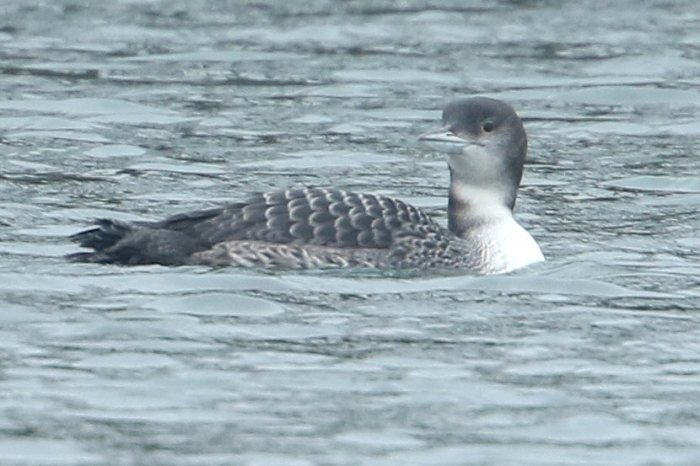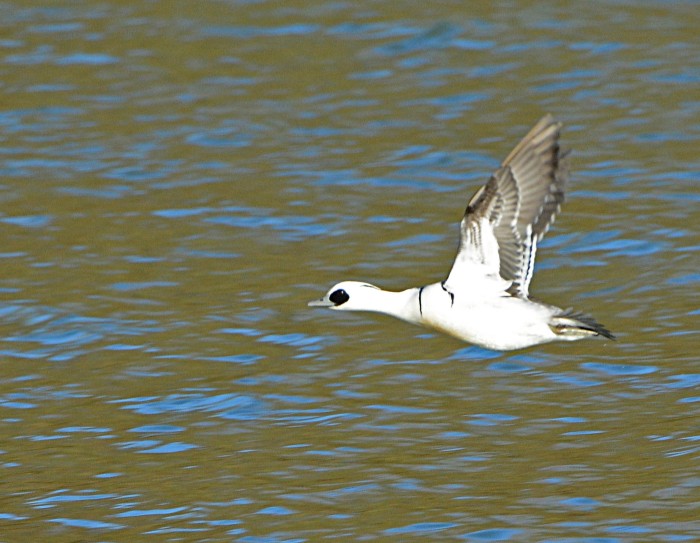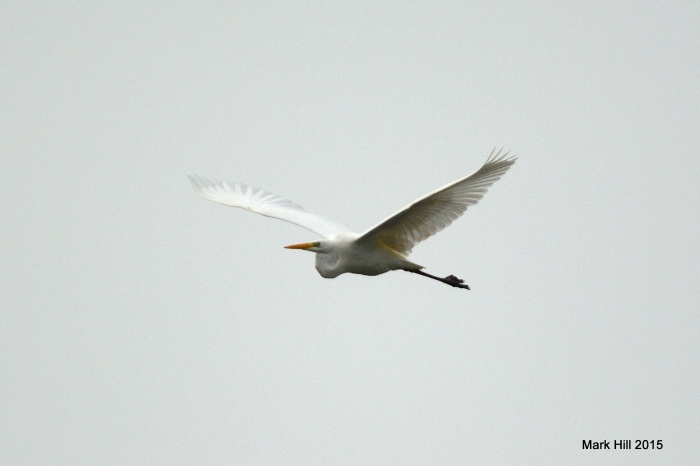Sunshine, showers, heavy rain and gale-force winds, still from the south-west, were the hallmarks of the last week of the year.
A Barnacle Goose at Clifford Hill GP on 27th and two with the Greylags at Cransley Res the following day failed to make up for the lack of any truly wild geese during the period, while the Ruddy Shelduck returned from Sywell CP to Pitsford Res, where it was

present again from 26th. The striking-looking drake Chiloe x Eurasian Wigeon hybrid was again at Summer Leys LNR on 29th. The only other ducks of note were a first-winter drake Scaup at Stortons GP on 31st and three drake Smew at Pitsford Res on 27th, two


of which had relocated to Ravensthorpe Res two days later, remaining there until 31st. One drake remained at Pitsford and a ‘redhead’ was also there on 28th.

The juvenile Great Northern Diver remained throughout on the watersports pit at Ditchford GP as did a Great White Egret on Viaduct Pit until at least 29th. Three Great Whites were present at Pitsford on 26th with one until 29th and four on 31st, while one at

Summer Leys LNR on 28th was joined by a second individual the following day. The Red-necked Grebe remained off the dam at Pitsford Res all week, although it roamed as far east as ‘The Holly Tree’, beyond Moulton Grange Bay on 29th.

Raptors this week were few and far between with, for the first time in three months, the long-staying second calendar year male Marsh Harrier not being reported from Summer Leys, while single Peregrines were in the Brampton Valley on 29th and at Pineham, Northampton on 31st and a male Merlin was seen at Stanford Res on the first of these two dates.
This week’s Golden Plovers counts included two hundred at Ditchford GP and at least two hundred and fifty at Clifford Hill GP on 27th, two hundred near Chipping Warden on 29th and fifty-six at Pineham, Northampton on 31st. The only Redshanks were four at Ditchford GP on 27th and the one at Pitsford Res the following day, while the only Green Sandpiper reported was one Ravensthorpe Res on 29th – the same day that the week’s only Common Snipe was seen at Hollowell Res.
Scarce gulls were limited to single adult Caspian Gulls at Hollowell Res on 29th and at Pitsford Res in the gull roost the following evening, while the latter site produced an adult and a first-winter Yellow-legged Gull on 26th and Hollowell held two adult Yellow-leggeds on 29th.
Two Short-eared Owls were again at Stanford Res on 29th; the rough ground east of the feeder stream and visible from the minor road is still paying dividends.


The only Stonechats this week were two at Clifford Hill GP on 28th and, on the following day, two were at Hollowell Res and singles at Pitsford Res and Summer Leys. The week’s

only Brambling was at Hanging Houghton on 29th and the East Hunsbury, Northampton Mealy Redpoll again visited a garden feeder with Lesser Redpolls on 26th-27th.

 and last week’s Great White Egret was also still there on Viaduct Pit on 20th. Other long-staying Great White Egrets were one at Ravensthorpe Res and up to two still at Pitsford Res during the period. This week also saw the discovery of another Bittern – this time at Stanwick GP on 20th. The Red-necked Grebe remained off the dam at Pitsford Res until at least 20th, although it’s still likely to be present there. Is anyone looking?
and last week’s Great White Egret was also still there on Viaduct Pit on 20th. Other long-staying Great White Egrets were one at Ravensthorpe Res and up to two still at Pitsford Res during the period. This week also saw the discovery of another Bittern – this time at Stanwick GP on 20th. The Red-necked Grebe remained off the dam at Pitsford Res until at least 20th, although it’s still likely to be present there. Is anyone looking?

 This week’s raptors included the long-staying second calendar year male Marsh Harrier at Summer Leys LNR on 19th and an unidentified harrier species south of Broughton the following day, while single Peregrines were at Buckby Wharf on 19th and Blueberry Farm, Maidwell on 21st, the latter site producing a Merlin on the same date and another Merlin was seen at Ditchford GP on 23rd.
This week’s raptors included the long-staying second calendar year male Marsh Harrier at Summer Leys LNR on 19th and an unidentified harrier species south of Broughton the following day, while single Peregrines were at Buckby Wharf on 19th and Blueberry Farm, Maidwell on 21st, the latter site producing a Merlin on the same date and another Merlin was seen at Ditchford GP on 23rd.


 Ditchford GP the following day, while the usual handful of Central European Blackcaps lingered in some of the county’s favoured gardens, with a new male visiting an East Hunsbury (Northampton) garden on 20th – the same garden also producing what appears to be the county’s only 2015 Mealy Redpoll from 19th to 24th.
Ditchford GP the following day, while the usual handful of Central European Blackcaps lingered in some of the county’s favoured gardens, with a new male visiting an East Hunsbury (Northampton) garden on 20th – the same garden also producing what appears to be the county’s only 2015 Mealy Redpoll from 19th to 24th.














